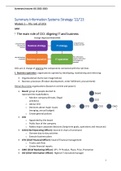Summary lectures ISS 2022-2023
Summary Information Systems Strategy ‘22/’23
Module 1 – The role of CIOs
SAM:
CIOs are in charge of aligning the components connected with the red lines
1. Business operation: organizations operate by developing, maintaining and enforcing:
• Organizational charts (see image below)
• Business processes (Product development, order fulfilment, procurement)
Hierarchical view organizations (based on control and power):
• Board: group of people elected to
represent the stakeholders
o Monitor company (threats, illegal
activities)
o Advise CEO
o Decisions about major issues
(merging, annual budget)
o Create general policies
• CEO
o Appointed by the board
o Public face of the company
o Makes major corporate decisions (long-term goals, operations and resources)
• COO (Chief Operating Officer): Second in chain of command
o Oversee day-to-day activities
o Execute business plans
• CFO (Chief Financial Officer): head of financial management
o Tracks cash flow
o Create financial reports
• CMO (Chief Marketing Officer): 4P’s → Product, Place, Price, Promotion
• CIO (Chief Information Officer): Highest IT executive/manager
1
,Summary lectures ISS 2022-2023
2. IT operation: IT department operates by developing, maintaining and enforcing use of:
• IT assets: valuable IT-related people or things
o Business software applications, user interfaces, IT processes, data, users, IT
staff, IT infrastructure (= hardware, software, network)
• IT management capabilities: related to adding, maintaining, removing and using IT
assets effectively and efficiently
o IT management processes (= process that deals with adding, maintaining,
removing and using IT assets under the supervision of the CIO → hiring a new
IT employee)
o IT management organization:
Information System (IS): a system that facilitates gathering, processing, storing, using, and
disseminating information. Information Technology (IT): the use of computers to implement
information systems.
Business application (program to perform business activities) types:
• Operational support systems: controlling and monitoring the day-to-day activities to
facilitate operational efficiency
• Market information systems: monitoring product sales and market- and product
trends to facilitate flexibility in responding to the market
• Strategic decisions support systems: long-term planning, making strategic decisions
and high level of internal and external analysis to facilitate futurity, proactiveness
and analysis
• Inter-organizational systems: exchange of data between organization and
customers, suppliers and government to facilitate coordination of companies
IT staff: IT help desk, infrastructure staff, security staff, business application manager,
development staff, IT directors
3. Business strategy: plan of action designed to achieve a long-term or overall aim. Business
strategies are corporate strategy (Samsung), strategic business strategy (Samsung Mobile
Phones) and functional strategy (marketing, HR, logistics, etc.)
2
,Summary lectures ISS 2022-2023
There are 2 generic strategies:
• Differentiation: product and services with unique features (i.e. Cadillac, Apple),
achieved by:
o Superior designs, customer intimacy, brand image, innovative R&D
• Cost leadership: lowest average unit costs in the industry (i.e. Chevrolet, Motorola),
achieved by:
o Cost minimization, operational excellence, achieving more efficiently than
rivals
3 types of firms (based on their strategies):
These 3 types of configurations can be explained using 6 strategy attributes:
4. IS/IT strategy: A plan of action for IS and IT to achieve a long-term goal
IS strategy:
• Is about what is required by business and thus is business demand-oriented
• Focusses on required business applications and information
• Defines and prioritizes the investment in business applications
• Goals is an ideal application portfolio (= an organization's collection of business
applications) and an IS project roadmap (= prioritization of IS projects)
IT strategy:
• Is about how the requirement can be delivered and thus is supply-oriented
• Focusses on technology and the goal is to achieve ideal technological assets
• Defines and prioritizes the investment in IT assets.
3
, Summary lectures ISS 2022-2023
Future application portfolio:
• Business strategy identifies: what new capabilities are required, which capabilities
must be improved, and what capabilities are becoming obsolete
• IS strategy identifies: what new applications are required, what new features should
be added and what applications are becoming obsolete
• IT strategy identifies: what new IT assets are required and what IT assets are
becoming obsolete
3 types of IS strategy:
• IS for efficiency: efficiency of internal and inter-organizational and long-term
decision making
o IS helps with tight cost management, automated processes, remote working
• IS for flexibility: market flexibility and quick strategic decisions
o IS helps with monitoring product sales, monitor trends, R&D and engineering
for developing new products, better collaboration among marketing
• IS for comprehensiveness: making comprehensiveness decisions and quick
responses through using knowledge of other organizations
o IS helps with having a comprehensiveness view of customers, supply chain
Alignment types (see Strategic Alignment Model begin module 1):
• Business alignment (aligning business strategy and business operation): the degree
to which the higher level, externally focused business strategies are aligned with the
lower level, internally focused business infrastructure and processes
• Strategic alignment (aligning business- and IT strategy): the degree business strategy
supports and is supported by the IT strategy
• IT alignment (aligning IT strategy and IT operation): the degree to which the higher
level, externally focused IT strategies are aligned with the lower level, internally
focused IT infrastructure and processes
• Operational alignment (aligning IT- and business operation): the lower level,
internally focused operational level of alignment deals with how the business
infrastructure and processes align with the IT infrastructure and processes
CIO focusses on strategic, IT and operational alignment
1. Business alignment:
• Business strategy-IT governance alignment
o If business strategy is differentiation the CIO should report to the CEO,
because the CEO has a cross-functional view of the firm and its customers
o If business strategy is cost leadership the CIO should report to the CFO
o Else: misalignment
4




